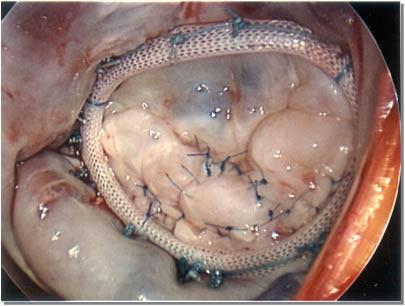Surgeon Q&A: What’s The Difference Between Primary & Secondary Mitral Regurgitation?
By Adam Pick on August 17, 2016
At the recent American Association for Thoracic Surgery meeting in Baltimore, I was very lucky to connect with Dr. Vinay Badhwar, the executive chair of the West Virginia University Heart & Vascular Institute. During our chat, we had a very interesting conversation about the differences between primary and secondary mitral regurgitation.

I wanted to learn more. So, after I got home from Baltimore, I emailed Dr. Badhwar to see if he would help me put together a “Surgeon Q&A” about this very important topic. Guess what? As you will see below, Dr. Badhwar agreed! 🙂

1. What is mitral regurgitation? What are the common symptoms?
Dr. Badhwar Says: Mitral regurgitation or “MR” is a backward leakage of the central valve of the heart, the mitral valve. The mitral valve is a one-way valve that works like a set of two French doors that meet in the middle. It is made up of the doors (known as leaflets) and the door frame (known as the annulus). When a problem occurs with either the door (leaflet) or the door frame (annulus), the valve can leak. When MR occurs, blood leaks from the left ventricle, backward across the mitral valve, into the left atrium, then backwards into the lungs.
This is why the most common symptom is shortness of breath, fatigue, or even a dry cough. It may occasionally be misinterpreted, particularly in non-smokers, as new adult-onset or exercise-induced asthma. Other common symptoms can be palpitations or the sensation of a “skipped” beat. Similarly, a sign of longer standing MR may be atrial fibrillation, or an irregular heart rhythm. Rarely, one may have occasional chest pains. When the MR becomes severe, the heart can weaken and one can develop more significant shortness of breath, fluid on the lungs, swelling of the feet, and what is commonly known as “congestive heart failure”.

2. Are there different types of MR? Please explain the differences between primary and secondary MR?
Dr. Badhwar Says: First, the most common form of mitral valve disease is “mitral valve prolapse” or a floppy valve. This may be benign and watched conservatively if the valve does not leak. However, once the valve does begin to leak, it should be watched closely with annual heart ultrasounds, or “echocardiograms”. If the leakage becomes severe, that is when mitral valve repair should be considered.
There are generally two ways the mitral valve can leak:
- Using the earlier analogy, if there is a primary defect with the “leaflets” or doors, such as with severe mitral valve prolapse, there is excess tissue or a loose or ruptured support chord that is the cause of the MR. This is called Primary Mitral Regurgitation.
- If a dilatation of the heart muscle were to occur, such as with a heart attack, a defect of the “annulus” or door frame occurs. This results in a secondary stretching of the annulus and the leaflets pull apart causing Secondary Mitral Regurgitation.

3. Does primary MR progress faster (causing more damage to the heart) than secondary MR?
Dr. Badhwar Says: It is true that the mechanisms and impact of the different types of MR may be different. However, the overall impact of severe MR to one’s heart and symptoms are very similar. The heart stretches or enlarges, develops worsening function, and symptoms of shortness of breath and fatigue worsen. If atrial fibrillation develops as part of this cascade, one’s symptoms may rapidly deteriorate. Overall, MR begets MR. This means that as MR worsens, the ventricle dilates and the annulus stretches, thus further increasing MR.
This is the cycle of congestive heart failure. Often the heart muscle in secondary MR may have existing challenges that are a precursor to MR. Therefore, patients suffering from secondary MR have an overall poorer long term outcome over patients with primary MR. Positively, if the cycle of MR can be interrupted with valve surgery, many patients may recover their heart function. Depending on the timing of intervention, and the type of MR, one’s heart may return completely to normal.
4. As a surgeon, do you use different therapeutic techniques for primary and secondary MR? If so, what are they?
Dr. Badhwar Says: In general, my principle is to repair the mitral valve whenever possible. For primary degenerative MR, mitral repair is performed nearly 100% of the time. I utilize several techniques and tailor each repair to the patient’s specific anatomy that follows the guiding principle of creating a highly durable zone of coaptation for the mitral leaflets. This often involves both leaflet procedures as well as a mitral ring annuloplasty (fixing the doors and the door frame). For the past several years, I perform the vast majority of all isolated mitral valve repairs without going through the breastbone, in a robotically assisted minimally invasive manner. Patients do very well and often return home within 3-5 days and back to work or to full recovery in a matter of a few short weeks.

For secondary MR, the valve leaflets themselves are often normal but the annulus and the structures below the valve are stretched out and pulled down into the ventricle. In many cases, secondary MR caused by early annular dilatation, can be repaired with a reduction annuloplasty ring. However, when the ventricle and annulus are severely stretched, a ring alone often is not enough to repair the valve. In these cases, additional techniques are added such as supportive methods for the ventricle or the leaflet to strengthen the repair. In certain cases when there is just too much stretching of the mitral valve and annulus, mitral valve replacement is the most prudent and durable option.
5. We’ve been hearing a lot about transcatheter mitral valve devices. What types of new technologies (TMVr and TMVR) are being used to treat primary and secondary MR?
Dr. Badhwar Says: Mitral valve repair remains the most optimal procedure to treat MR – often with the best long term outcome. A new area of therapy that is emerging for patients of very high risk with severe MR, is transcatheter mitral valve repair (TMVr) and transcatheter mitral valve replacement (TMVR). These therapies are reserved for when patients are too sick or frail to tolerate mitral valve operations. These involve placing catheters in a vein or in the tip of the heart and deploying a device to solve MR in a minimally invasive manner. A dedicated team of physicians, a Mitral Heart Team, work together to deliver these therapies (surgeons, cardiologists, anesthesiologists).
The only FDA-approved TMVr device currently available is the MitraClip. This device is deployed by the use of a small catheter via the major leg vein, navigated from the right to left top chamber, called atria, and then brought down to the mitral valve. The MitraClip acts like a clothes-pin to “pinch” a portion of the two leaflets together to reduce MR. Preliminary results have been quite good for patients without other options, reducing the amount of MR and often significantly improving symptoms.
TMVR is a new procedure that is still in development. These devices are deployed on a large catheter that is currently introduced through a small incision on the left chest and inserted in the tip of the heart. This catheter then facilitates the deployment of an artificial valve across one’s native mitral valve to fix the MR. These devices are currently only being offered to patients as part of an FDA-approved clinical trial investigation. One such device is known as the Tendyne device. These are available only in a limited number of centers in the United States.

For patients with severe MR, I always evaluate patients first for minimally invasive mitral valve surgery. Only when patients are too high risk for surgery, do I then offer patients TMVr or TMVR. The choice of the type of device is based on the patient’s mitral anatomy and risks. Access to these innovative devices allows us to provide a full range of life-saving options to the broadest number of patients with MR as possible.
For more information on transcatheter new technologies, our readers can see this recently published paper for an overview.
I don’t know about you… But, for me, that explanation was downright awesome! Many thanks to Dr. Badhwar for taking the time to explain the differences between primary and secondary mitral regurgitation along with his approach for treating MR using minimally invasive and catheter-based techniques.
Keep on tickin!
Adam













